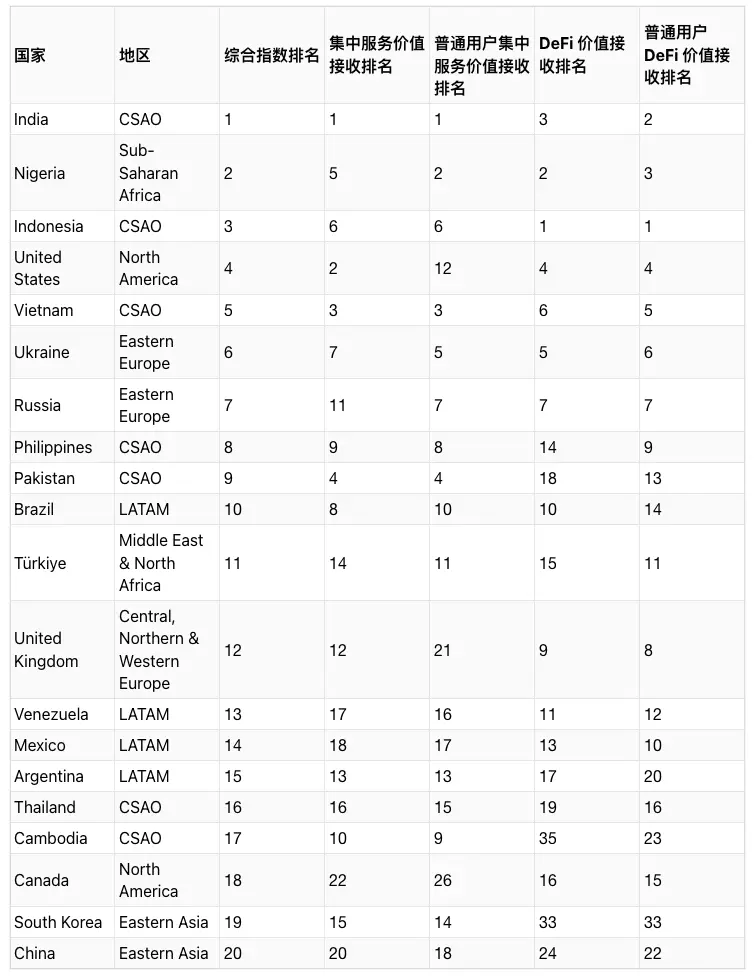2024 Global Cryptocurrency Adoption Survey: South Asia and Oceania Lead the World in Cryptocurrency Adoption
Author: Chainalysis Team
Compiled by: Deep Tide TechFlow

Check your country's ranking in the 2024 Chainalysis Global Crypto Adoption Index through the interactive map.
This article is excerpted from our 2024 Geography of Cryptocurrency Report.
We are excited to share the fifth annual Chainalysis Global Crypto Adoption Index. In each year's report, we analyze on-chain and off-chain data to determine which countries are leading in grassroots cryptocurrency adoption. Our research highlights the unique cryptocurrency use cases emerging in these countries and explores why people around the world are choosing to embrace cryptocurrency.
Continue reading to learn more:
Our Methodology for the Global Crypto Adoption Index
The Global Crypto Adoption Index consists of four sub-indices, each based on the usage of different types of cryptocurrency services in various countries. We rank all 151 countries that have sufficient data for each sub-index. We weight the rankings based on characteristics such as population size and purchasing power, calculate the geometric mean for each country across the four sub-indices, and then normalize the final results to a range of 0 to 1, assigning each country a score to determine its overall ranking. The closer a country's final score is to 1, the higher its ranking.
To calculate our sub-indices, we estimate the transaction volume of different types of cryptocurrency services and protocols in each country based on the traffic patterns of these service and protocol websites. We acknowledge that there are limitations to traffic data, as some crypto users may use tools like VPNs to hide their true physical locations. However, given that our index covers hundreds of millions of cryptocurrency transactions and over 13 billion website visits, any misattributed transaction volume due to VPNs is negligible in such a large dataset. We also compare our findings with insights from local crypto experts and operators worldwide, which enhances our confidence in this approach.
Below are descriptions of the sub-indices and how they are calculated, along with improvements to our methodology since last year.
Sub-index Category 1: On-chain cryptocurrency value received from centralized services calculated by GDP per capita adjusted for purchasing power parity (PPP)
We introduce this sub-index to rank countries based on the total cryptocurrency value received from centralized services, weighting the rankings to favor those countries where this amount is higher relative to average income. To calculate this, we estimate the total value received on-chain by users of centralized services in each country, weighted by GDP per capita adjusted for purchasing power parity (PPP), which reflects the income of each resident in that country. The higher the ratio of on-chain value received to GDP per capita adjusted for PPP, the higher the ranking. In other words, if two countries receive the same amount of cryptocurrency from centralized services, the country with the lower GDP per capita will rank higher.
Sub-index Category 2: On-chain retail cryptocurrency value received from centralized services calculated by GDP per capita adjusted for purchasing power parity (PPP)
We also estimate the activity of non-professional individual cryptocurrency users on centralized services, based on the value of the cryptocurrency they transact compared to the average purchasing power. We achieve this by estimating the amount of cryptocurrency received by users in each country on centralized services, but only counting retail transactions valued below $10,000. We then rank countries based on this metric, weighting the rankings to favor countries with lower GDP per capita (adjusted for PPP).
Sub-index Category 3: On-chain cryptocurrency value received through decentralized finance (DeFi) protocols calculated by GDP per capita adjusted for purchasing power parity (PPP)
We rank countries based on their DeFi transaction volume, weighting the rankings to favor countries with lower GDP per capita (adjusted for PPP).
Sub-index Category 4: On-chain retail cryptocurrency value received through decentralized finance (DeFi) protocols calculated by GDP per capita adjusted for purchasing power parity (PPP)
We rank countries based on their DeFi transaction volume in retail-scale transfers (again, cryptocurrency valued below $10,000), weighting the rankings to favor countries with lower GDP per capita (adjusted for PPP).
Changes in Methodology
Methodology Change 1: Measuring DeFi Activity
The main change in this year's methodology is how we measure the value of cryptocurrency received through decentralized protocols. For DeFi services, we only consider the value received from suspicious individual wallets, excluding the value received from other known DeFi wallets. This new methodology ensures that the total received value is not inflated due to intermediary steps required by certain smart contracts.
Here is an example of how DeFi transfers typically operate:
An individual wallet initiates a swap in DeFi protocol A, transferring Ether (ETH) from the individual wallet to the router contract address of DeFi protocol A.
ETH is deposited into the wrapped Ether (wETH) token contract from the router contract address.
The router contract receives wETH.
A transfer is made from the router contract to the decentralized exchange (DEX) pool contract.
A transfer is made from the DEX pool contract back to the router contract.
Finally, a transfer is made from the router contract back to the individual wallet.
According to our new methodology, we only calculate the first transfer in the example above to determine the total value received by the DeFi protocol. This way, we can eliminate intermediary transfers between contracts of the same service provider. This process has led to a reduction in our estimates of received value, but the current estimates are more accurate.
Methodology Change 2: Exclusion of P2P Exchange Sub-index
In previous years, we included P2P cryptocurrency transaction volume in our calculations, weighting it by per capita purchasing power parity (PPP) and the number of internet users to calculate the overall global cryptocurrency adoption ranking. This year, we decided to exclude this sub-index due to a significant decrease in P2P exchange activity. Notably, one of the oldest P2P exchanges, LocalBitcoins.com, closed last year, leading to this decline.
Top 20 Countries in the 2024 Global Crypto Adoption Index
Central and Southern Asia and Oceania (CSAO) dominates our 2024 index, with seven countries making it into the top 20. As mentioned in our full report, CSAO has a range of unique crypto markets, with high levels of activity from local exchanges, as well as active merchant services and decentralized finance (DeFi).

Global Crypto Activity Continues to Grow
Between Q4 2023 and Q1 2024, the total value of global crypto activity surged to levels higher than during the 2021 crypto bull market. We can observe this trend in the chart below, where we summarize and re-index the index scores of 151 countries from Q3 2021 to Q2 2024 to showcase the growth in global adoption.

Last year, the growth in cryptocurrency adoption was primarily driven by low- and middle-income countries. However, this year, cryptocurrency activity has increased across all income tiers, although high-income countries have seen a decline since the beginning of 2024.

When we observe year-over-year growth in different service types, we find that decentralized finance (DeFi) activity has significantly increased in Sub-Saharan Africa, Latin America, and Eastern Europe. As shown in the chart above, this growth may have spurred increased altcoin activity in these regions.

When we observe year-over-year growth in service types, we find that decentralized finance (DeFi) activity has significantly increased in Sub-Saharan Africa, Latin America, and Eastern Europe. As shown in the chart above, this growth may have spurred increased altcoin activity in these regions.

To learn more about these trends, recent regulatory developments, and how countries around the world are using cryptocurrency, read the full 2024 Geography of Cryptocurrency Report.









